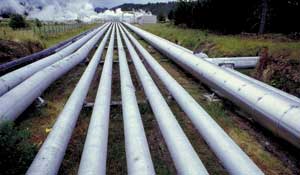Improving biodiesel logistic efficiencies: Pipe dream turns to the pipeline

April 25, 2007
BY Paul Nazzaro, National Biodiesel Board director of petroleum affairs
With the tremendous growth of biodiesel refining capacity and the steady demand from biodiesel consumers, the logistic strategies serving the renewable fuel's industry must be updated and streamlined. Biodiesel companies have traditionally relied on transport trucks and railcars to satisfy the nation's growing appetite for biodiesel and its blends. The million-dollar questions are: How does the industry continue to satisfy customers' supply needs when the national demand rises to 350 million gallons and beyond, and what will be required if and when biodiesel blends are to be transported on U.S. pipelines?
Through continued financial support from the U.S. DOE and USDA, and the project coordination services of the National Biodiesel Board (NBB), the NBB's petroleum outreach team has worked tirelessly with national pipeline companies exploring the feasibility of moving biodiesel blends. There are approximately 200,000 miles of oil pipelines crisscrossing the United States. America relies on oil pipelines to meet its growing energy needs; therefore, the biodiesel industry may also need to rely on the pipelines to help secure a long-standing place in the national energy landscape.
Some interesting facts retrieved during the petroleum team's research indicated that shipping a gallon of gasoline from Houston to New York Harbor costs only 3 cents via pipeline. Pipelines transport more than 17 percent of all freight moved in America, yet pipelines only account for 2 percent of the country's freight bill.* In contrast, moving a 5,000- to 6,000-gallon load via truck would cost 20 cents or more per gallon, while rail would be 10 cents or more per gallon. Clearly, petroleum pipelines could help reduce the economic and efficiency disparities of various modes of liquid fuel transportation.
So, where are we? The industry's first attempt at shipping, conducted by Colonial Pipeline last summer, revealed that a B5 blend shipped from Pasadena, Texas, to Linden, N.J., demonstrated no adverse impact to the base fuel specification. All ASTM D 975 specifications were acceptable, and contained no water or sediment traces. Countrymark Co-op conducted a B5 run in Indiana on its company-owned pipeline last summer with similar positive results. B5 has been run in pipelines in Europe on a daily basis for years.
These results indicated a successful pipeline movement on systems that don't carry jet fuel, which rules out Colonial Pipeline. Three important issues remain for biodiesel to be allowed on pipelines that do carry jet fuel: What level of biodiesel can be allowed in jet fuel without harming jet fuel properties, how does one measure the level, and what type of procedures are needed to ensure the level of biodiesel in jet fuel is below the limit? The NBB has agreed to work with pipeline and ASTM leadership to identify a resolution to these important questions. Several other national pipeline partners have agreed to work cooperatively with our petroleum outreach team to establish additional movements of biodiesel within their systems. They say they want to support the NBB's efforts to open the national pipeline network to efficiently and economically move biodiesel from coast to coast. The NBB feels that would help take biodiesel to that next, mainstream level.
*Source: A briefing paper from the American Petroleum Institute's Association of Oil Pipelines
Through continued financial support from the U.S. DOE and USDA, and the project coordination services of the National Biodiesel Board (NBB), the NBB's petroleum outreach team has worked tirelessly with national pipeline companies exploring the feasibility of moving biodiesel blends. There are approximately 200,000 miles of oil pipelines crisscrossing the United States. America relies on oil pipelines to meet its growing energy needs; therefore, the biodiesel industry may also need to rely on the pipelines to help secure a long-standing place in the national energy landscape.
Some interesting facts retrieved during the petroleum team's research indicated that shipping a gallon of gasoline from Houston to New York Harbor costs only 3 cents via pipeline. Pipelines transport more than 17 percent of all freight moved in America, yet pipelines only account for 2 percent of the country's freight bill.* In contrast, moving a 5,000- to 6,000-gallon load via truck would cost 20 cents or more per gallon, while rail would be 10 cents or more per gallon. Clearly, petroleum pipelines could help reduce the economic and efficiency disparities of various modes of liquid fuel transportation.
So, where are we? The industry's first attempt at shipping, conducted by Colonial Pipeline last summer, revealed that a B5 blend shipped from Pasadena, Texas, to Linden, N.J., demonstrated no adverse impact to the base fuel specification. All ASTM D 975 specifications were acceptable, and contained no water or sediment traces. Countrymark Co-op conducted a B5 run in Indiana on its company-owned pipeline last summer with similar positive results. B5 has been run in pipelines in Europe on a daily basis for years.
These results indicated a successful pipeline movement on systems that don't carry jet fuel, which rules out Colonial Pipeline. Three important issues remain for biodiesel to be allowed on pipelines that do carry jet fuel: What level of biodiesel can be allowed in jet fuel without harming jet fuel properties, how does one measure the level, and what type of procedures are needed to ensure the level of biodiesel in jet fuel is below the limit? The NBB has agreed to work with pipeline and ASTM leadership to identify a resolution to these important questions. Several other national pipeline partners have agreed to work cooperatively with our petroleum outreach team to establish additional movements of biodiesel within their systems. They say they want to support the NBB's efforts to open the national pipeline network to efficiently and economically move biodiesel from coast to coast. The NBB feels that would help take biodiesel to that next, mainstream level.
*Source: A briefing paper from the American Petroleum Institute's Association of Oil Pipelines
Advertisement
Advertisement
Advertisement
Advertisement
Upcoming Events





